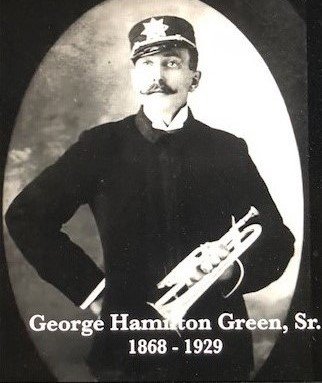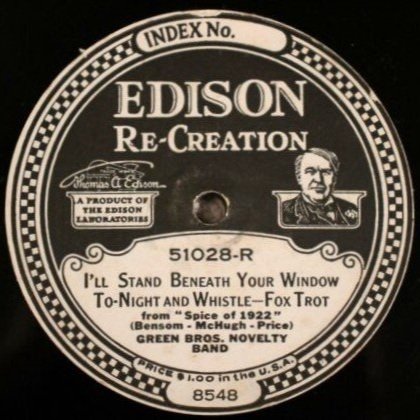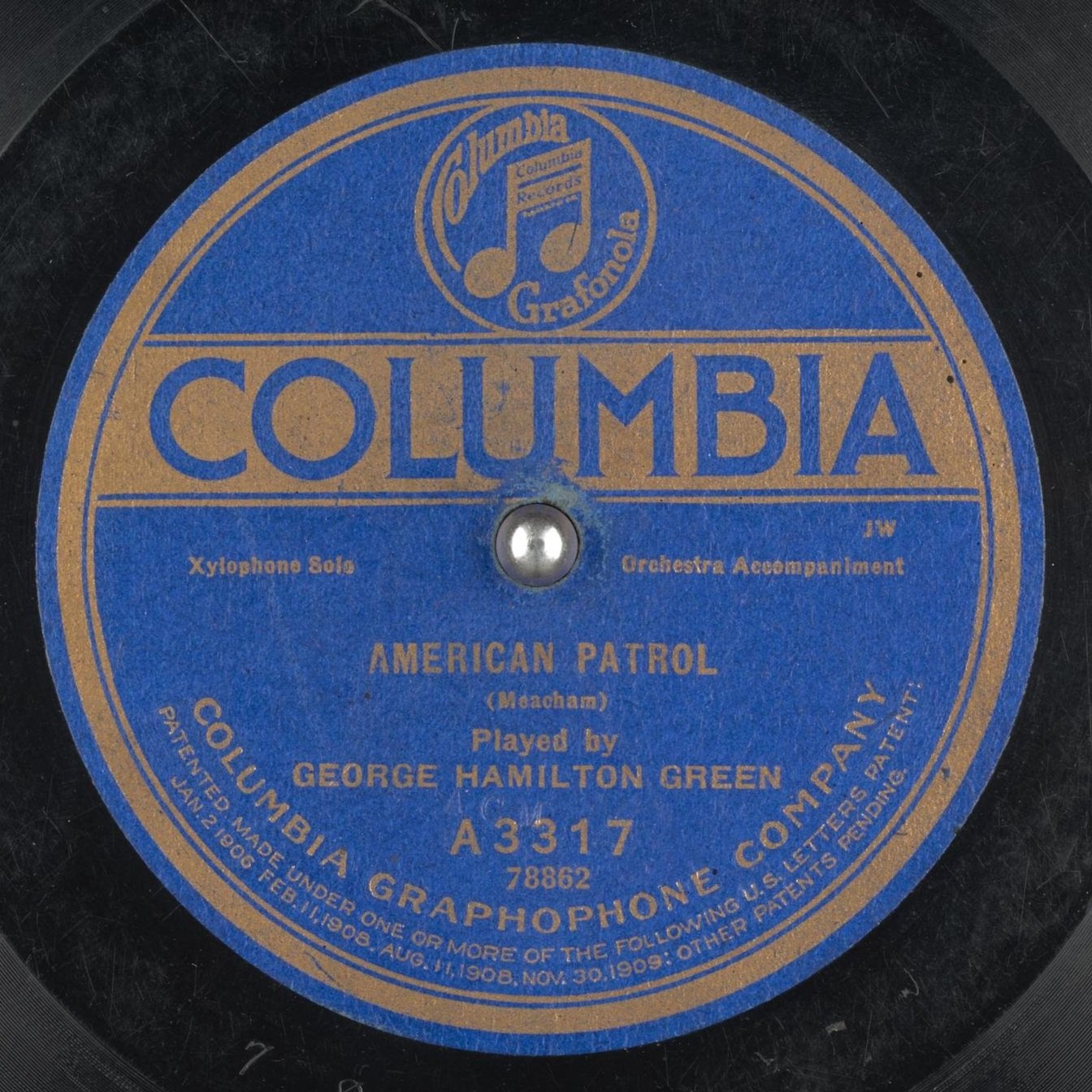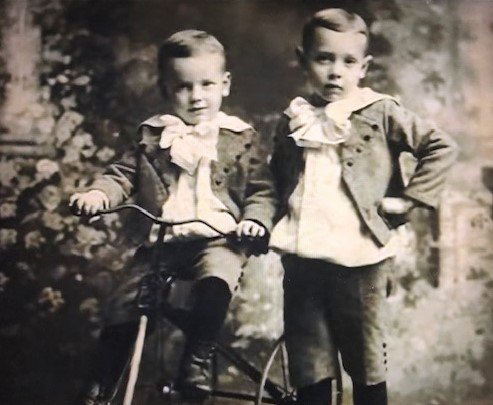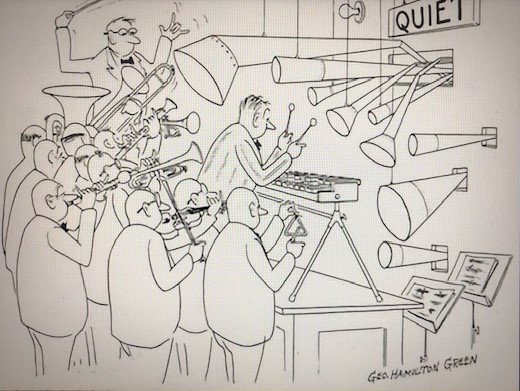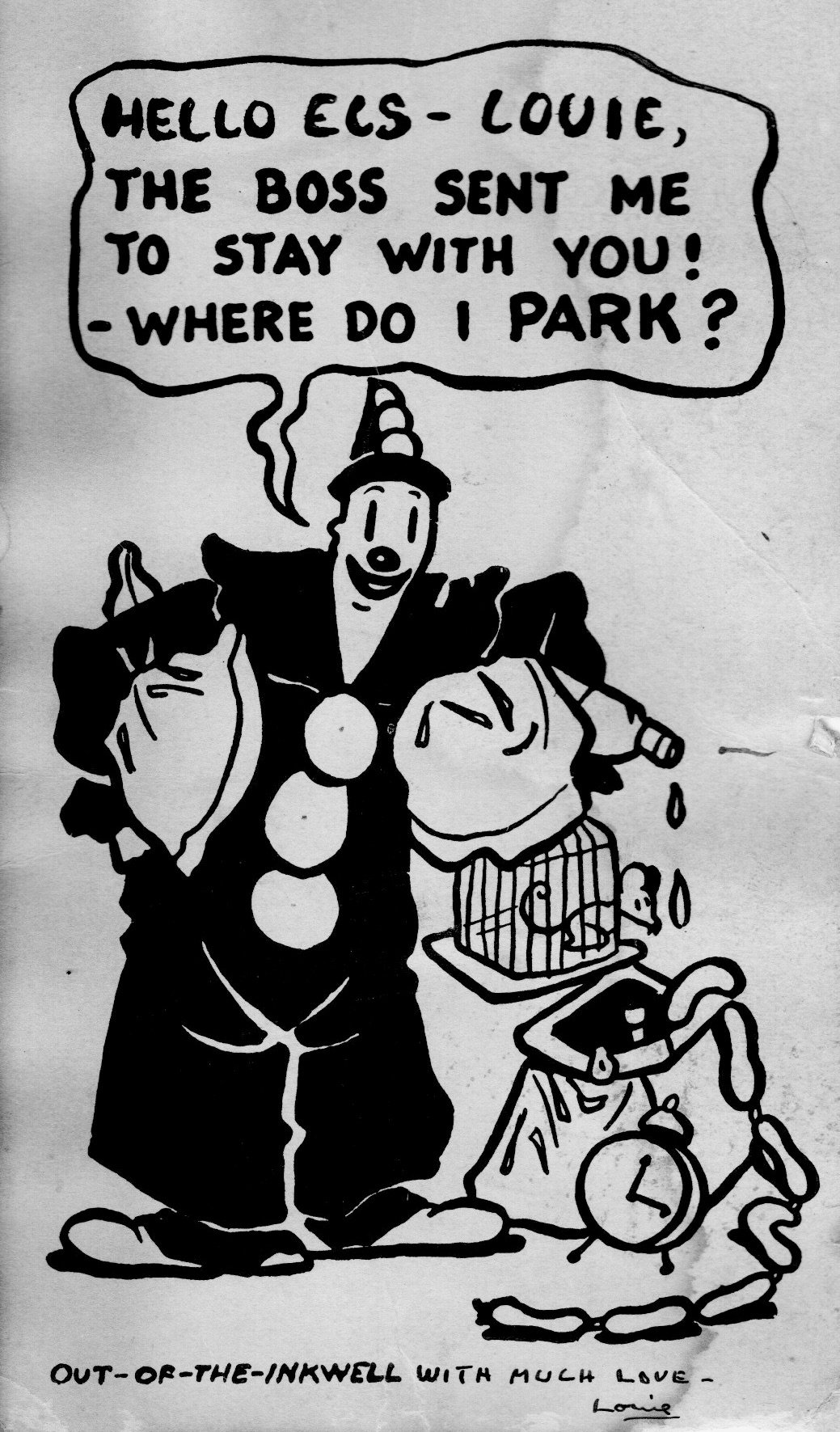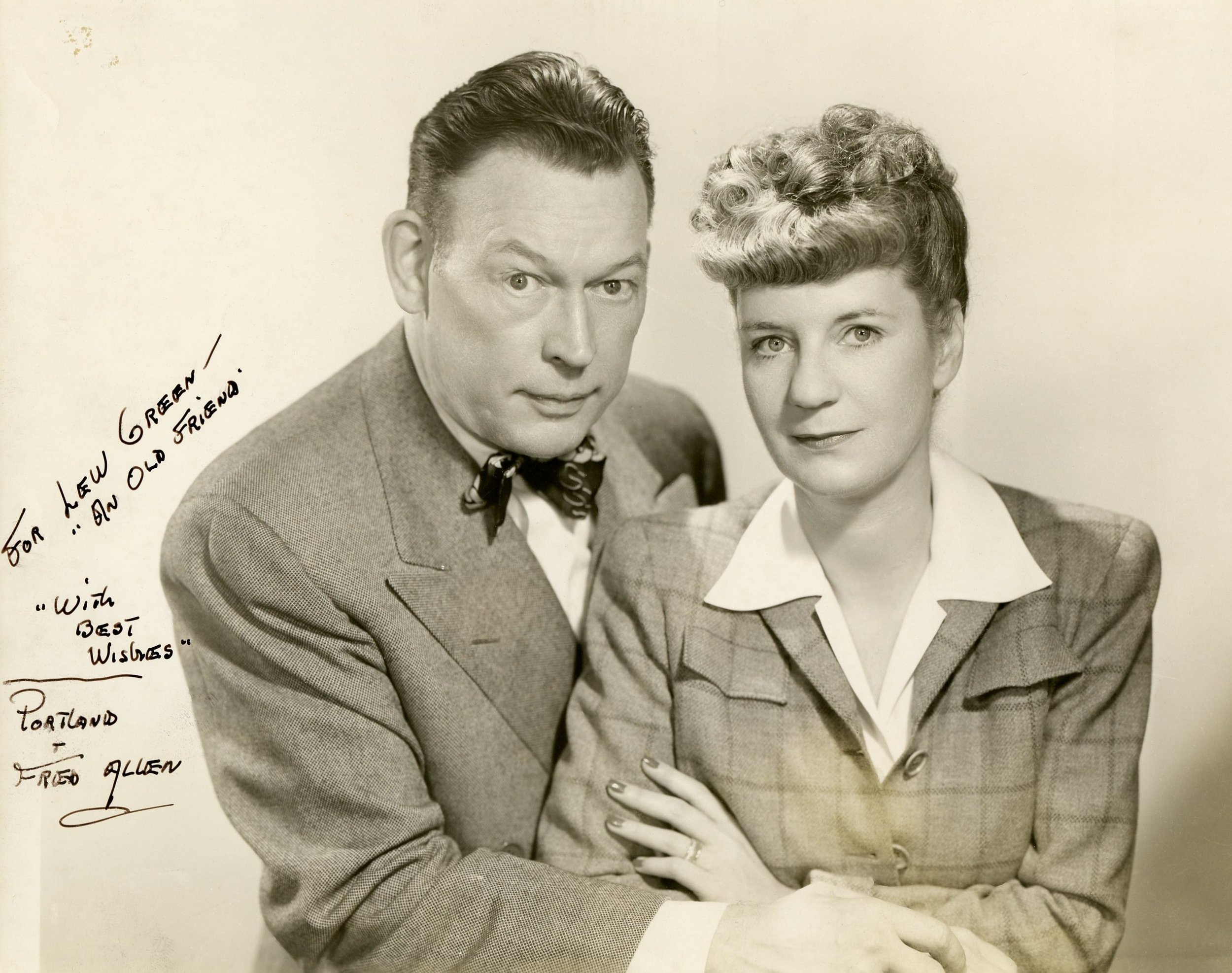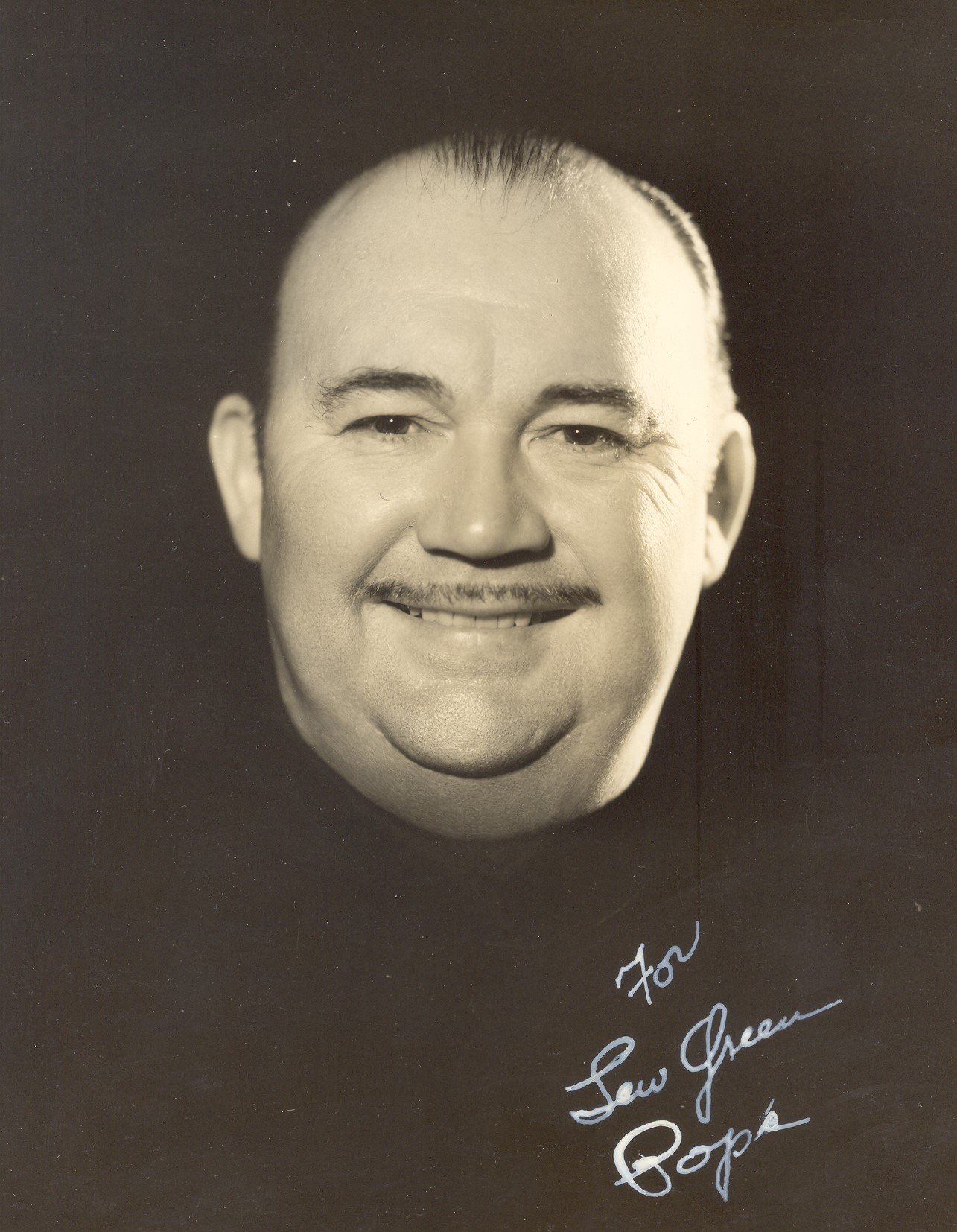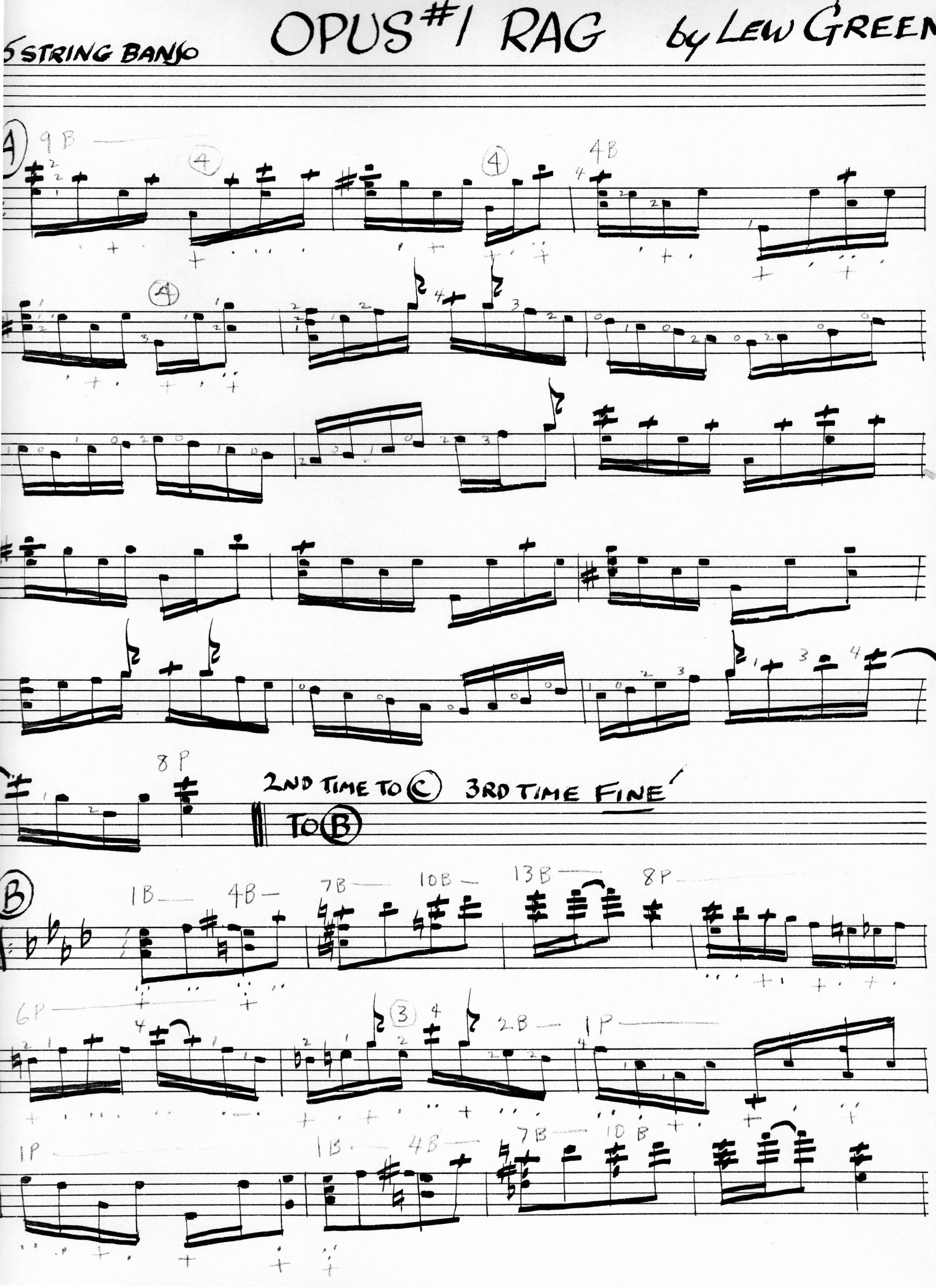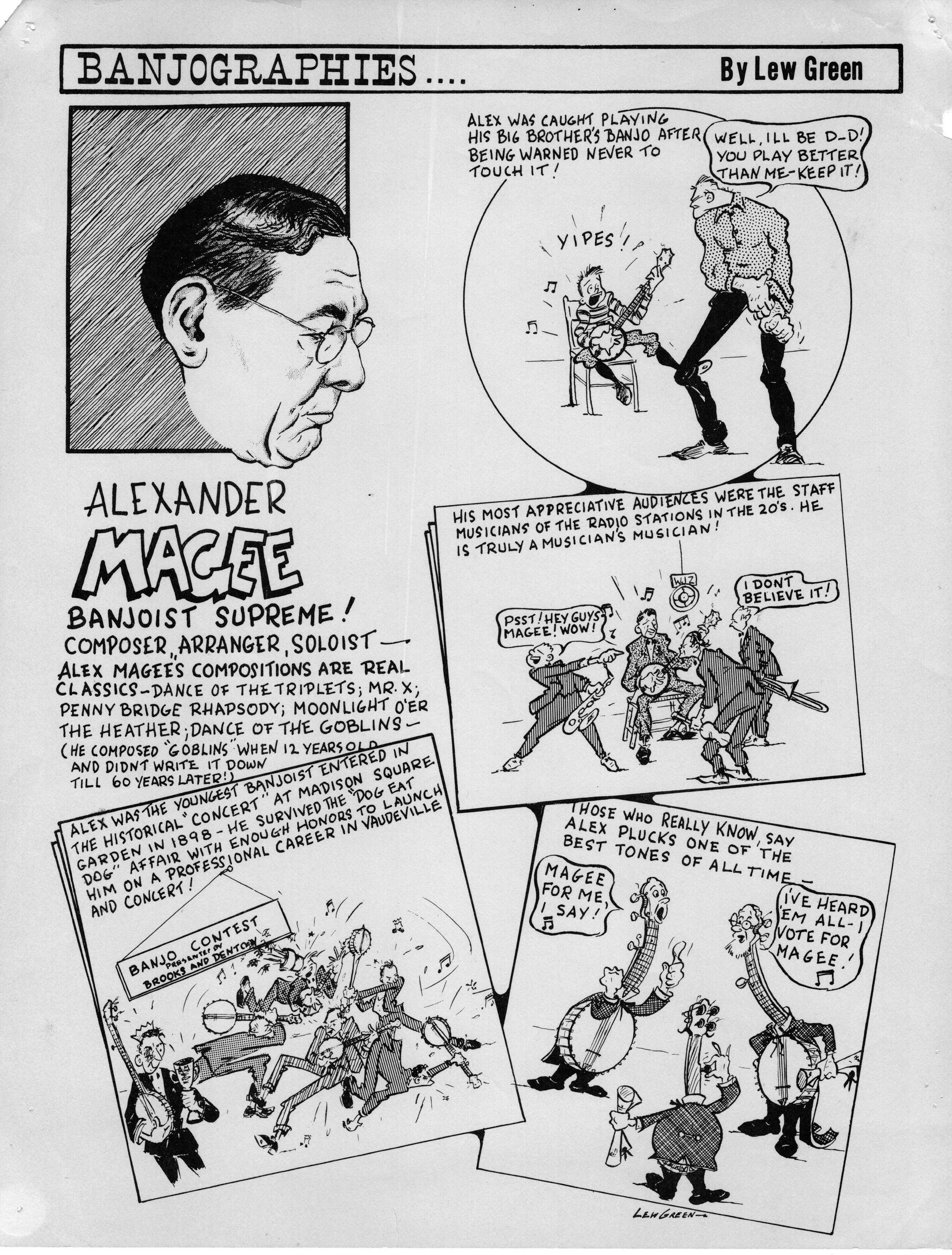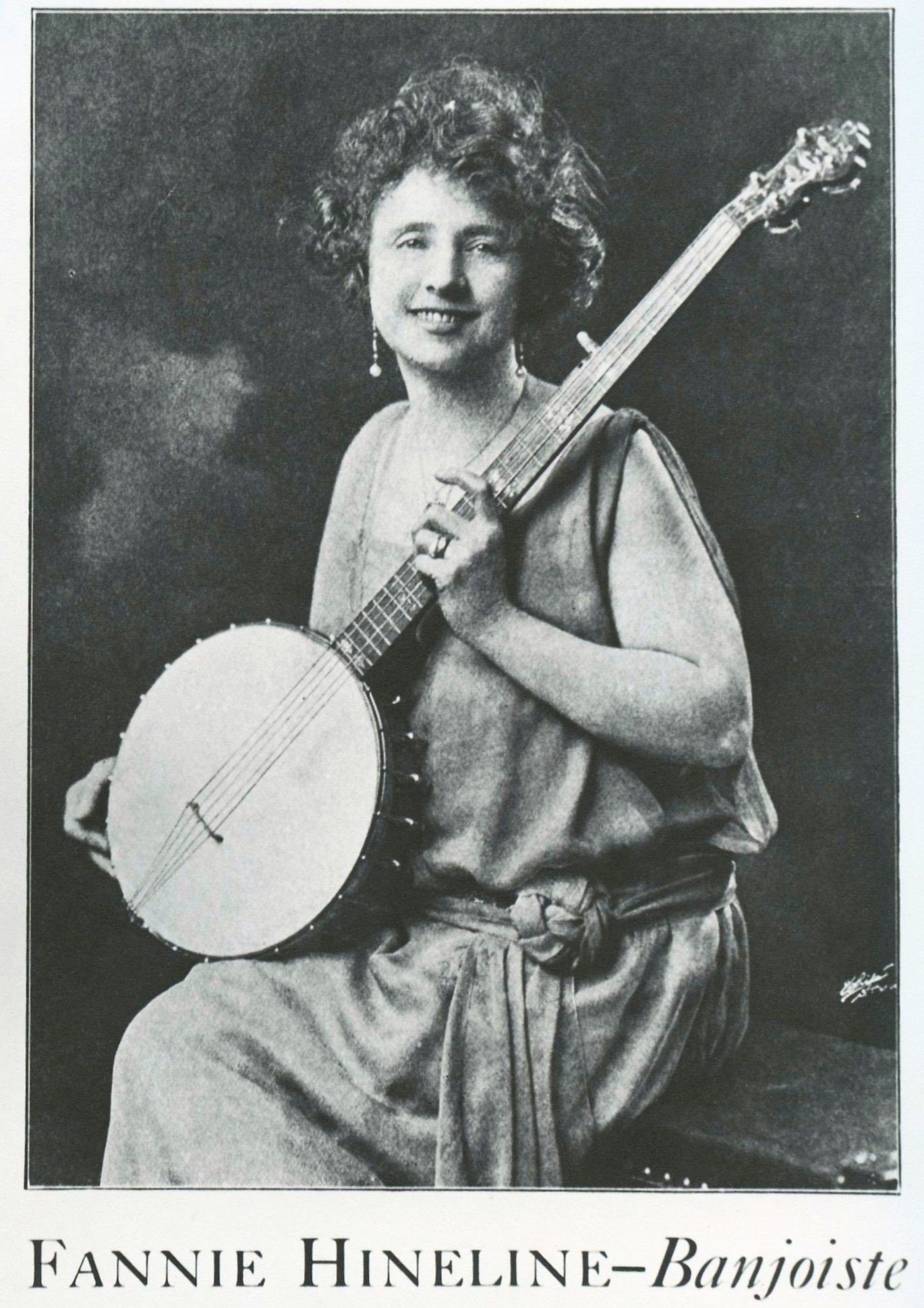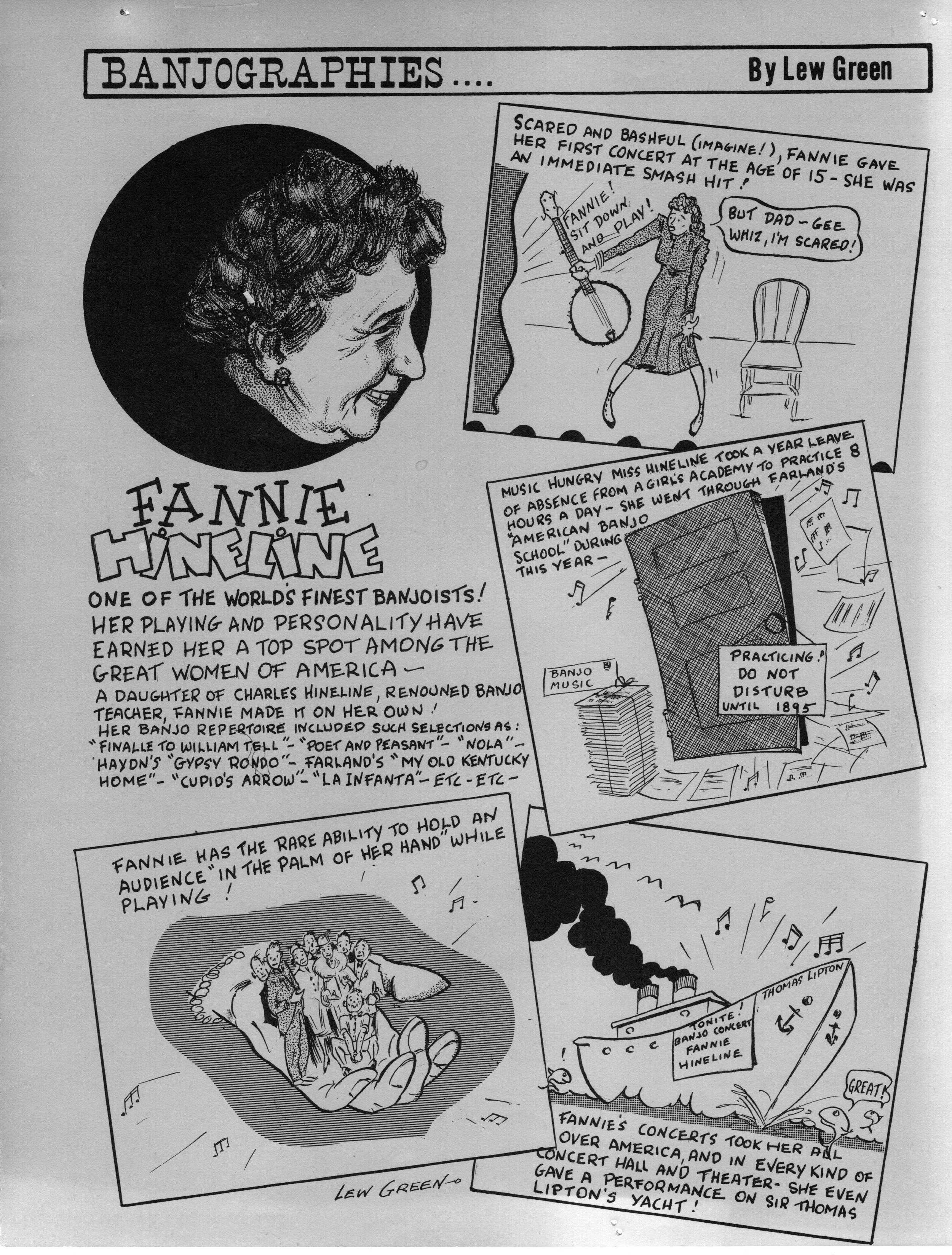LEWIS GOODRICH JOHN (LEW) GREEN
Guitarist, Banjoist, Composer, TV & Radio Producer, Cartoonist, Photographer, Cinematographer, Advertising Executive
MAN & MUSIC
b. October 25, 1909, Omaha, Nebraska - d. June 14, 1992, Long Grove, Illinois
Lew Green (Sr.) is a name unfamiliar to many. This lack of recognition belies his achievements, even though he's touched generations of film and television producers, the legions of viewers that tune in to the small and big screen, and the multitude of electric guitar players. Few know any of this. As the youngest of a long line of composers and musicians in one of America's premier musical families, he was a protege of Eddie Lang, assisted Walt Disney during the production of his first three sound films, was a core member of the Big Apple's recording & broadcast stable during the 1930s and '40s, and used his brain power to conceive ways to amplify the acoustic guitar. His place in American entertainment deserves acclaim for these accomplishments alone. To appreciate Lew Green, Sr., one has to understand the significant American musical family that gave birth to him.
One of America’s premier musical families, the Green family tree was planted in the mid-1800s when band leader, violinist, and key bugle player Joseph C. Green (1833-1924) moved from Poughkeepsie, New York, to Omaha, Nebraska, where he formed the 7th Ward Silver Cornet Band. His son, George Hamilton Green (1868-1929), a cornet player, became the leader of his father’s band in 1889 and changed the name to George Green’s band shortly after.
Joseph C. Green (3)
George Hamilton Green Sr. (3)
George Hamilton Green Band, Omaha, Nebraska, 1889. (3)
The next generation of Greens brought three notable musicians onto the stage.
Joseph Peter (Joe) Green (1892-1939)
Xylophone, Vibraphone, Marimba, Orchestra Leader, Composer, Arranger, Celeste, Percussion, Bells,
Green Brothers’ Business Manager & Booking Agent. (33)
Joe Green (3)
George Hamilton Green Jr. (1893-1970)
Xylophone, Vibraphone, Marimba, Celeste, Percussion, Bells, Orchestra Leader, Composer, Arranger, Teacher, Cartoonist, Inventor. (34)
George Hamilton Green, Jr. (3)
Lewis Goodrich John (Lew) Green (1908-1992)
Guitar, Banjo, Composer, Radio & Television Producer, Cartoonist, Photographer, Cinematographer, Advertising Executive.
Lew Green with Ferde Grofe Orchestra, Carnegie Hall, NYC, January 19, 1937. (3)
The Green Brothers: Joe, Lew, George, Central Park, NYC c. 1928. (3)
Cornetist, collector, and producer Lewis Goodrich (Lew) Green Jr. (1938-) and his son Jeffrey Hamilton Green (1962-), a clarinet, bass, soprano, and C-melody saxophonist, carry on the Green family tradition to this day.
Green's New Novelty Orchestra
Arnie Kinsella, Drums; John Gill, Guitar, Banjo; Lew Green, Cornet; Dan Block, Clarinet; Vince Giordano, Basses; Mary Murfitt, Violin; Herb Gardner, Trombone; Mary Green, Piano; Ian Finkel, Xylophone. (3)
Jeff Hamilton Green's International Jazz & Ragtime All-Stars
Mary Green, Piano; Jeff Green, Bass Saxophone; Lew Green, Cornet; Sean Moyses, Banjo. (3)
The Green Brothers’, narrated by Lew Green, Jr.
The Green Brothers’ (Joe & George Hamilton Jr.) were a dynamic franchise. Virtuoso's, Joe and George were two of the most prolific recording & broadcast artists in New York City in the mid-teens through the late 1930s, recording hundreds of sessions on virtually every record label of the day.
Note: It is thought that there are thousands of recordings featuring the Green Brothers’. (31)
GREEN BROTHERS’ NOVELTY BAND
George & Joe with the Green Brothers’ arsenal of instruments, including xylophones, marimba’s, bells, and bass banjo. c. 1927. (3)
A small sample of pop & jazz recordings by the Green Brothers’ (1924-1936).
George & Joe Green
GEORGE HAMILTON GREEN
Alabama Moon, Sam Fox Publishing Co., 1920.
All Star Trio: George Hamilton Green-xylophone, F. Wheeler Wadsworth-saxophone, Victor Arden-piano. (3)
1921 cover version of George Hamilton Green’s 1920 tune Alabama Moon by Olive Klein & Elsie Baker.
Olive Klein
Elsie Baker
TRIPLETS is a tour de force performed by the composer. Recorded several times with orchestral accompaniment, this 1926 recording features the xylophonist with Frank Banta on piano.
JOE GREEN
Xylophonia & The Whirlwind, accompanied by Milt Herth on Hammond Organ, was recorded in NYC on June 17, 1938. (42)
These two Joe Green selections, recorded on the same day in 1938 for Decca Records, are an extraordinary display of composition and technique. With XYLOPHONIA, the stream of 32nd notes appear to float across the bars. Joe Green composed this piece for xylophone in the tradition of saxophone virtuoso Rudy Wiedoeft's SAXOPHONIA. (40) XYLOPHONIA & THE WHIRLWIND have remained staples in the repertoire of xylophonists.
In the 1930’s, the Green Brothers’, collectively and on their own, began producing pre-recorded programs that were leased to radio stations for local broadcast. In October 1933, 33 companies competed in creating transcriptions. (36) These electrical transcriptions (ETs) ran for approximately fifteen minutes per side (often containing four or five selections per side) and were pressed on sixteen-inch vinyl discs playing at 33 1/3 rpm. This Joe Green transcription dates from c. 1936 and features the Joe Green Novelty Marimba Band performing A BUNCH OF ROSES, THE SWEETHEART OF SIGMA CHI, CIGARETTE, AY MAMA INES, MOONLIGHT AND ROSES. (3)
Joe Green Orchestra, NBC Radio Broadcast. (3)
Where else can we find two brothers who play the same instruments and possess equal talent of this depth? Sixteen months later, on October 16, 1939, Joe Green went into the hospital for an appendectomy and died from complications following the operation; he was 47. George Green retired soon after that and went on to a successful career as a cartoonist.
George Hamilton Green
George Hamilton Green
In 1928, all three brothers worked with Walt Disney, recording and then synchronizing the music with the animation of his first three animated cartoons. A first in film history!
The Skeleton Dance. (37)
Released: August 22, 1929
Steamboat Willie. (39)
Released: November 18, 1928
The Opry House. (38)
Released: March 28, 1929
Steamboat Willie is especially notable for being one of the first cartoons with synchronized sound, as well as one of the first cartoons to feature a fully post-produced soundtrack, which distinguished it from earlier sound cartoons, such as Inkwell Studios' Song Car-Tunes (1924–1926) and Van Beuren Studios' Dinner Time (1928). Disney believed that synchronized sound was the future of film. Steamboat Willie became the most popular cartoon of its day. (9)
Mickey Mouse first appeared in Disney’s 1928 animated cartoon Steamboat Willie. On the 25th anniversary of Mickey’s debut, Walt Disney presented Lew Green with this autographed gift. (3)
LEW GREEN
The youngest of the three Green Brothers’ (by sixteen years), as a child, Lew Green was a violin, piano, and banjo student.
Lewis Goodrich John Green age 8, Omaha, Nebraska, 1916. (3)
1920’s
Lew Green joined the Green Brothers’ Orchestra in late 1927, playing banjo & guitar on their recordings and radio broadcasts.
Green Brothers’ Novelty Orchestra, c. 1929 Temple Radios Show, CBS Radio Broadcast. (3)
George, Joe, Lew Green, c. 1929. (3)
Across the four years he was with "the Brothers'," Lew Green was a protege of Eddie Lang, studied with Joseph Schillinger, assisted Walt Disney during the production of his first three films, worked in the Fleischer Studios animation department, was a core member of the Big Apple's recording & broadcast stable, and used his brain power to conceive ways to amplify the acoustic guitar. This occurred before he was twenty-one, a testament to his immense talents.
While working at Fleischer Studios, Lew took time to have Koko the Clown send a marriage proposal to his future wife Elsie (ELS), c. 1929. (3)
As a cartoonist, he developed the “Henry Peck” cartoon series. Unable to sell the idea, he discards the project, c. 1930. (3)
1930’s
By 1930, having mastered the six-string archtop guitar, he was picking up the overflow recording and broadcast work for Eddie Lang, Dick McDonough, and Carl Kress.
June 6, 1930: Brunswick Records Recording Session, NYC. (26)
Irving Mills and His Hotsy-Totsy Gang
Bix Beiderbecke-cornet, Ray Lodwig-trumpet, Jack Teagarden-trombone, Benny Goodman-clarinet, alto saxophone, Larry Binyon-tenor saxophone, Joe Venuti-violin, Nat Brusiloff-violin, Frank Signorelli-piano, Lew Green-guitar, Min Leibrook-bass saxophone, Gene Krupa-drums.
LOVED ONE-Melotone 12051-Take B
Kate Smith w/Lew Green, The Big Broadcast, 1932.
A showcase for some of the biggest radio stars of the day, Paramount Pictures, The Big Broadcast is a musical comedy interspersed with “radio broadcast” appearances by The Boswell Sisters, George Burns & Gracie Allen, Arthur Tracy, The Mills Brothers, Cab Calloway, Vincent Lopez, and the film’s star, Bing Crosby (accompanied by Eddie Lang). Kate Smith appears singing IT WAS SO BEAUTIFUL with Lew Green accompanying, seated to her right.
The guitarist toured and broadcast with “The songbird of the South” through 1937.
Kate Smith and Her Swanee Music Revue, Steel Pier, Atlantic City, September 1933-Lew Green, standing, second row, far right. (3)
The Big Broadcast lobby card, 1932.
April 1936, Epiphone ad, Metronome.
Lew Green endorsed Epiphone instruments for both their electric guitar (Electar) and archtop acoustic (De Luxe) models, making a national name for himself as the first and preeminent electric Hawaiian guitar soloist while broadcasting with composer, arranger, and orchestra leader Ferde Grofe. Green’s performance of the song WHEN DAY IS DONE with the Grofe Orchestra on the Bankers Association of America’s radio show with Fred Allen in the 1930s is thought to be the first coast-to-coast transmission of the sounds of the electric Hawaiian guitar. (13)
Ferde Grofe & Lew Green with the Electar Hawaiian aka Electrophone & amplifier, 1937. (3)
Electar Hawaiian 1935. (13)
Lew Green playing the Electar Hawaiian with combination case (amplifier), 1935. (13)
Grofe had a long reach, which allowed the guitarist to work with some of the era’s biggest stars, including Burns and Allen, Bing Crosby, Kate Smith, Fred Allen, and Paul Whiteman.
Fred Allen & wife, Portland (Hoffa) (3)
Ed Kirkeby (3)
Paul Whiteman (3)
Nat Shilkret (3)
By the mid-1930s, Lew Green started to set his sights on moving away from the spotlight to producing & directing radio shows.
c. 1937: NBC Radio Broadcast, NYC.
Steinie Bottle Boys Swing Club (radio show), NBC-Blue Network, NYC. (3)
Lew Green-producer, musical director, guitarist.
LEW GREEN SR.: “We broadcast three times weekly. I paid (the musicians) $125 bucks for the three shows, paid $125 for a weekly guest star to appear (Duke Ellington, Fats Waller, Bunny Berigan, Eva Taylor). (The band included) Jimmy Lytell-clarinet, Johnny Gart-trumpet, Charles Magnante-accordion, Charlie Barber-trombone, Dick McDonough-guitar (1936-37), Tony Mottola-guitar (1937-38), Chauncey Morehouse-drums. (14)
Here’s an excerpt from the Steinie Bottle Boys Swing Club radio show featuring Lew Green-Electar solo, and Tony Mottola-acoustic guitar solo.
Steinie Bottle Boys Swing Club, KDKA Radio
Pittsburgh, Pennsylvania, newspaper ad.
1940’s
Moving to Chicago in 1942, Lew formed his own agency to produce radio and transcription recordings. From 1943 to 1945, he produced Don McNeill's Breakfast Club, which was broadcast on the NBC Blue Network from The Merchandise Mart in Chicago. Toastmaster McNeill hosted the weekday morning variety show.
Don McNeill’s Breakfast Club, The Merchandise Mart, Chicago, c. 1943-1945. In the booth to the back left is the production team of Lew Green-producer, Kermit Slobb-writer, Johnny Erp, and Joe Drips. (3)
Green’s sterling production of McNeill’s Breakfast Club was briefly sidelined when he was involved in a scrap with the musicians' union that called for his removal from the program! The newspaper clips lay out both sides of the story. Lew Green came out as the winner.
Wednesday, January 10, 1945, Chicago Tribune, IL.
Tuesday, January 30, 1945, The Bradenton Herald, FL.
Thursday, January 11, 1945, Daily News, NY.
Thursday February 1, 1945, The Oregonian, Portland.
Here’s an excerpt from the program featuring Lew Green and Les O’Keefe’s song HIGH HAT HATTIE (FROM CINCINNATI). The clip is an edit combining Ranny Weeks 1940 Vocalion record with a portion of the live broadcast.
1948
PHOTOGRAPHY AND MORE RADIO PRODUCTION
Friday, May 7, 1948 The Daily Herald, Chicago, IL.
Friday, November 12, 1948, Arlington Heights Herald, IL
1950’s
In 1950, Lew Green and his company, Green Associates, produced the syndicated radio show "The Red Grange Football Show" hosted by the Chicago Bears' all-time all-American player, "The Galloping Ghost" Red Grange.
Green Associates flier for “The Red Grange Football Show” c. 1950. (3)
One of Lew Green’s “Sportsketches” c.1950. (3)
In 1951, Lew and Charlie Henderson produced and wrote the music (with Pat Ballard) for the IGA (Independent Grocers Alliance) Jubilee (25th Anniversary) Revue.
Note: (Charles Henderson) Songwriter ("Deep Night"), composer, conductor, pianist, arranger, and author, educated at Roxbury Latin School and Harvard University (cum laude), BA, and a student of Walter Piston, Ernst Toch, and Victor Bay. He was a pianist and vocal arranger for orchestras, musicals, and radio. Between 1949 and 1951, he was a composer, arranger, and musical director for film studios and television productions, and he created and conducted Las Vegas night club acts and wrote special material for the shows. Joining ASCAP in 1931, his chief musical collaborators included Rudy Vallee, Tom Waring, Edward Heyman, Mack Gordon, and Alfred Newman. (41)
Bio page from the 1951 IGA Jubilee Revue Program. (3)
The Eddie Ballantine and Lew Green team composed and produced several records in the 1950s and '60s. Friends and collaborators, Green & Ballantine first met while working on Don McNeill's Breakfast Club (Ballantine was the program's musical arranger and then orchestra leader).
A THOUSAND TIMES by Lew Green, Eddie Ballantine, and Marie Leslie gets a rockabilly treatment for Coral Records stable vocalist Chuck Murphy. Released on 78rpm in August 1951, the record, and for that matter Murphy, didn’t have much luck on the Decca subsidiary label. The song may have had success had it been recorded by Decca artists such as Jimmie Davis, Bill Monroe, or Red Foley.
Ballantine & Green’s IT’S A WONDERFUL WORLD is a catchy two-beat sing-along featuring the Jack Halloran Singers. (That’s John Cali playing the banjo). Don’t confuse this with the 1939 Savitt/Watson/Adamson tune of the same name, a favorite of jazz bands & singers. This 45rpm and several others produced by the duo were not for sale but only available for jukebox play. (3)
As a cinematographer for the Chicago Bears, Lew filmed game action for later viewing by coaches and players, becoming one of the first producers of televised NFL games, including the home games of the Chicago Bears and Chicago Cardinals. (3)
Chicago Bears 1955.
Chicago Cardinals 1955.
In 1952, as producer & host, Lew created demos for a radio show he called “The Collectors Corner.” Unfortunately, despite the excellent programs, the idea never developed beyond the demo stage. Featured on one of the shows was the maestro of the five-string banjo, Fred Van Eps. Recorded on a busy train platform at Union Station in Chicago as Van Eps was on his way to Lewistown, Pennsylvania, for a banjo rally, the interview captures Van Eps sharp as a tack and candid. Whether the producer/host knew it then, his brief encounter with the banjoist captured a rare and historic moment.
Note: Lew refers to Van Eps several times as 83 years old. This is not accurate. We know two things: first, the recording took place in the 1950s, and second, the banjoist lived to be almost eighty-two (1878-1960). Until we get a handle on the exact date, we’ll assume that Van Eps was in his mid-seventies during the interview.
Fred Van Eps c. 1950’s. (3)
Starting in the late 1940s and continuing through the 1950s, Lew was one of the country’s foremost writers and producers of commercial spots and radio jingles, winning several national awards for his jingles. (35)
1960’s
Lew was president of the Chicago chapter of the National Academy of Recording Arts and Sciences and the Western Advertising Golfers Association.
The 1960’s saw him studying and composing for the five-string banjo. (3)
As a member of the American Banjo Fraternity, he produced several profiles on celebrated banjo players. (3)
Alexander Magee (3)
“Banjo” Bill Bowen (3)
Fred Van Eps & “Banjo” Bill Bowen, 1954 (3)
Fannie Hineline (3)
Frank C. Bradbury (3)
1970’s
Lew Green Sr. semi-retired in the mid-1970s. He kept himself busy playing golf and, when called upon, to create art. In 1974, his son Lew Jr. requested his dad to create a logo for his jazz band, The Ragtime Evolution Quartet. Within an hour of receiving the call, Green Sr. delivered what you see below.
The Ragtime Evolution Quartet logo by Lew Green Sr., 1974. (3)
On Sunday, November 25, 1979, Lew Green Sr. reunited with friend and colleague, guitarist & arranger Carmen Mastren. Lew Jr. recorded their get-together as the two veterans talked candidly about Eddie Lang, Dick McDonough, Carl Kress, Nick Lucas, Epiphone and more. Portions of the chat are transcribed and available at Lew Green ESSENTIALS & TIMELINE.
Mike Peters, Lew Green Sr., & Carmen Mastren, Darien, Connecticut, Sunday, November 25, 1979. (3)
Lew Green Sr. died on June 14, 1992, and was buried in Memorial Gardens, Arlington Heights, Illinois.
For more about Lew Green and his remarkable family, visit The Green Family Collection @ Kutztown University.
Kutztown University - The Center for Mallet Percussion Research at Kutztown University
114 Old Main, Kutztown, PA 19530
T: 610-683-4550
E: music@kutztown.edu
www.kucmpr.org/our-collections
Thanks to Lew Green Jr. for providing materials from the Green family archives and for his support in building this site in honor of his dad.
CITATIONS
1. The American Dance Band Discography, 1917-1942, Brian Rust, Arlington House, New Rochelle, NY, 1975.
2. Jazz Records, 1897-1942, 4th Revised and Enlarged Edition, Arlington House, New Rochelle, NY, 1978.
3. Green Family archive.
4. en.wikipedia.org/wiki/The_Big_Broadcast
5. www.imdb.com/title/tt0022675/locations?ref_=ttfc_sa_4
6. http://www.bingmagazine.co.uk/
7. www.readingeagle.com/2017/03/14/ku-to-honor-xylophone-legends-the-green-brothers-novelty-orchestra/
8. en.wikipedia.org/wiki/Kate_Smith
9. en.wikipedia.org/wiki/Steamboat_Willie
10. Tommy Dorsey, Livin’ In A Great Big Way, Peter J. Levinson, Da Capo Press, 2005
11. Plunkett’s, Josh Billings, Esquire Jazz Book, 1947.
12. www.imdb.com/title/tt0019422/fullcredits/?ref_=ttrel_ql_1
13. Epiphone, The House Of Stathopoulo, Jim Fisch, L.B. Fred, Amsco Publications, NY, 1996.
14. Sunday, November 25, 1979 @ the home of Lew Green Jr., Darien CT w/Lew Green Sr. & Carmen Mastren.
15. His sister was pianist Paquita Madriguera, the second wife of Andres Segovia.
16. Bix, Man & Legend, Richard M. Sudhalter & Philip R. Evans with William Dean-Myatt.
17. www.tapatalk.com/groups/bixography/the-first-newspaper-announcements-of-the-camel-ple-t6481.html?
18. www.otrcat.com/old-time-radio-show-ratings-by-year
19. nicklucas.com
20. ibdb.com
21. The Complete Entertainment Discography from the mid-1890’s to 1942, Brian Rust with Allen G. Debus, Arlington House, New Rochelle, NY.
22. banjofraternity.org
23. bingmagazine.co.uk
24. Lewis G. Green, Songwriter, Cinematographer for Bears, Chicago Tribune, June 21, 1992.
25. The Green Family Collection @ Kutztown University, www.kucmpr.org/our-collections
26. Bix, The Leon Bix Beiderbecke Story, Philip R. and Linda K. Evans, Prelike Press, 1998.
27. Lewis Goodrich John Green (Jr.), Certificate of Birth 24670.
28. Five Stringer, newsletter of the American Banjo Fraternity.
29. en.wikipedia.org/wiki/Schillinger_System#References
30. Discography of American Historical Recordings,
31. Masters of the Xylophones-George Hamilton Green and Joe Green, Xylophonia Music Co. XMC 001, 1993.
32. The Green Brothers’ MASTERS OF THE XYLOPHONE Collection, Xylophonia Co. & Green’s Music XMC 007, 2010.
33. en.wikipedia.org/wiki/Green_Brothers_Novelty_Band
34. en.wikipedia.org/wiki/George_Hamilton_Green
35. IGA Biography.
36. Russo, Alexander (2010).Points on the Dial: Golden Age Radio beyond the Networks. Duke University Press.
37. d23.com/a-to-z/skeleton-dance-the-film/
38. d23.com/a-to-z/opry-house-the-film/
39. d23.com/a-to-z/steamboat-willie-film/
40. www.youtube.com/watch?v=3yMwc8olTLE
41. www.imdb.com/name/nm0376367/
42. adp.library.ucsb.edu

